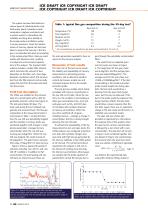 Website:
Gasmet Technologies
Website:
Gasmet Technologies
Catalog excerpts

ICR DRAFT ICR COPYRIGHT ICR DRAFT ICR COPYRIGHT ICR DRAFT ICR COPYRIGHT MERCURY MONITORING I Modern mercury monitoring by Antti Heikkilä, Gasmet, Finland Amid growing global concern for the toxic effects of mercury pollution, Antti Heikkilä, from Finnish monitoring instrumentation manufacturer Gasmet, highlights the challenges faced by mercury monitoring in cement kilns. He explains how a new continuous mercury monitoring system addresses these issues, and provides process operators with an opportunity to improve environmental performance and demonstrate compliance with upcoming legislation. he production of cement clinker is responsible for 10 per cent (189t in 2005) of anthropogenic mercury emissions to air, according to a UNEP study.1 Mercury and mercury compounds pass for the most part through the kiln and preheater. They are only partly absorbed by the raw gas dust, depending on the temperature of the waste gas. For these reasons, monitoring and controlling emissions of mercury to air is important and steps are being taken in several countries to impose emission limits. In the European Union BREF guidance for Cement kilns (CLM BREF), mercury has a BAT-associated emission level of 0.05mg/Nm3 (50µg/Nm3) for the halfhour average. Finnish manufacturer of emission monitoring instruments Gasmet Technologies has launched a new continuous mercury emission monitoring system based on the cold vapour atomic fluorescence (CVAF) measurement principle. The analyser is integrated in an air-conditioned cabinet together with a vacuum pump, an automatic calibrator and a nitrogen gas generator. The sample gas is extracted from the process duct with a dilution probe and heated sample line, specially designed for sampling mercury from harsh process conditions (see Figure 1). The analyser has a detection limit of 0.02µg/Nm3 and the lowest measuring range for total mercury concentration is 0-10µg/Nm3 when a dilution rate of 1:50 is used in the sample extraction probe. System overview Since the Continuous Mercury Monitor (CMM) mercury analyser employs a CVAF spectrometer, the sensitivity of the instrument is excellent. The main source of measurement uncertainty that Figure 1 right: Gasmet’s Continuous Mercury Monitor (CMM) system Figure 2 above: the cement kiln and stack where the CMM field trial was carried out needs to be addressed by the analyser and the system design is the quenching effect where other gases present in the sample, such as O2 and H2O, lower the fluorescence signal due to mercury atoms. To avoid this, a dilution sampling approach with the dilution gas, synthetic nitrogen, formed in a nitrogen generator inside the analyser cabinet. As the detection limit of the analyser is much lower than would be needed to monitor mercury in low µg/ Nm3 ranges, dilution does not compromise the sensitivity of the instrument. On the other hand, dilution lowers the quenching effect by reducing the concentration of interfering gases by a factor of 50. Measuring mercury in a gas consisting of 98 per cent nitrogen guarantees consistent measurement, regardless of the fuel or emission abatement techniques used in the plant. The CVAF spectrometer measures atomic mercury vapour (Hg0). To measure total mercury, including oxidised forms, a thermal catalytic converter is used to convert all forms of mercury, such as mercury chloride, into atomic mercury. The converter is close coupled with the fluorescence cell to minimise the risk of recombination reactions where the atomic mercury converts back to oxidised forms between the converter and spectrometer. MARCH 2014 I
Open the catalog to page 1
MERCURY MONITORING ICR DRAFT ICR COPYRIGHT ICR DRAFT ICR COPYRIGHT ICR DRAFT ICR COPYRIGHT The system has been field tested on various types of industrial plants (coalfired power plants, hazardous waste incinerators, sulphuric acid plants and a cement works) to characterise the suitability and long-term stability of the sample probe and dilution system in various processes. Given the reactive nature of mercury, special care has been taken to ensure that mercury in the flue gas is not absorbed into dust accumulating in the sample probe filters. Mercury reacts readily with limestone dust,...
Open the catalog to page 2
ICR DRAFT ICR COPYRIGHT ICR DRAFT ICR COPYRIGHT ICR DRAFT ICR COPYRI Table 2: values and interpretation of parameters used to calculate the response time of the CMM mercury analyser using Boltzmann Sigmoidal function Parameter Value Interpretation Lower stable state concentration Upper stable state concentration Time when midpoint of transition is reached Parameter indicating rate and direction of change (negative sign means decrease) the Microsoft Excel Solver package. The parameters of the response curve are summarised in Table 2. The response time was evaluated as T90-10, the...
Open the catalog to page 3All Gasmet Technologies catalogs and technical brochures
-
gasmet_dx4040
2 Pages
-
gasmet industrial computer
2 Pages
-
gasmet cems ii
2 Pages
-
gasmet_cems
2 Pages
-
gasmet_oxygen_analyzer
2 Pages
-
In-Situ FTIR Gas Analyzer
2 Pages
-
FCX-Series FTIR Gas Analyzer
2 Pages
-
Portable Calibrator
2 Pages
-
gasmet_cems_ii
2 Pages
-
gasmet_cx4000
2 Pages
-
stack_testing
2 Pages
-
gasmet_portable_sampling
2 Pages
-
DX4015
2 Pages
-
gasmet_heated_sampling_lines
1 Pages
-
Portable Sampling Unit
2 Pages
-
gasmet_dx4000_web
2 Pages






























